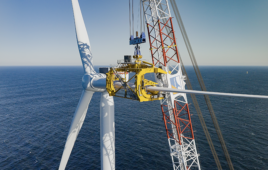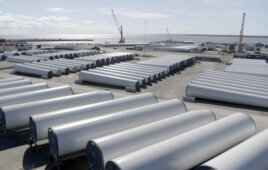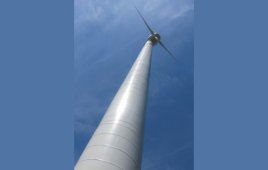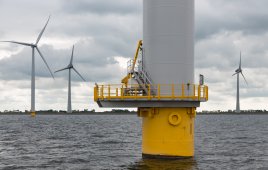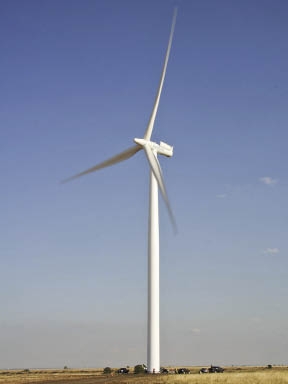 The U.S. Department of Energy’s National Renewable Energy Laboratory (NREL) and Siemens Energy Inc. have formally commissioned a 2.3 MW Siemens wind turbine at NREL’s National Wind Technology Center. The turbine is the centerpiece of a multi-year project to study the performance and aerodynamics of a new class of large, land-based machines in a program that will be the biggest government-industry research partnership for wind power generation ever undertaken in the U.S. For that commissioning and duty, the Siemens 2.3 unit is Windpower Engineering’s Turbine of the Month.
The U.S. Department of Energy’s National Renewable Energy Laboratory (NREL) and Siemens Energy Inc. have formally commissioned a 2.3 MW Siemens wind turbine at NREL’s National Wind Technology Center. The turbine is the centerpiece of a multi-year project to study the performance and aerodynamics of a new class of large, land-based machines in a program that will be the biggest government-industry research partnership for wind power generation ever undertaken in the U.S. For that commissioning and duty, the Siemens 2.3 unit is Windpower Engineering’s Turbine of the Month.
The turbine is said to mark the start of a new era of research at NREL’s Wind Technology Center, according to Director Dan Arvizu. “We will embark on a R&D program that will pave the way for more advanced wind turbines,” he said. Under the R&D agreement, the two organizations will test basic turbine characteristics and verify new performance-enhancing features of the pilot turbine over at least three years. Testing will include real-world operating conditions, including severe weather. Under the initial phase of the $14 million research program, Siemens will contribute $9 million and NREL $5 million.
“This research program will help us further enhance the performance of our turbines and lower the cost of clean, wind-generated power, which in turn will help diversify the overall mix of power generation sources in the U.S,” says Siemens Energy’s VP Barry Nicholls.
The 2.3-MW unit is among the largest land-based turbines deployed in the U.S. and is the largest at the Technology Center. Testing will examine structural and performance characteristics, aerodynamic and performance improvements, along with model, acoustics, and power-quality studies. The turbine is fitted with a 101-m diameter rotor (331 ft) and mounted atop an 80-m tower (262 ft).
NREL researchers also are interested in the below-ground structures (foundations) required to support such large turbines. NREL and wind-plant developer Renewable Energy Systems Americas (RES), Broomfield, Colo., (res-americas.com) have agreed to study the design and performance of turbine foundations, with goals of increasing the reliability of non-turbine components and reducing turbine installation costs.
“RES Americas installed several types of instruments to monitor foundation response to operating turbine loads,” says RES Civil Engineering Manager Jomaa Ben-Hassine. “Instruments include earth pressure cells that measure contact pressure between the foundation and the supporting soils, strain gages attached to select rebar to measure foundation stresses, and anchor- bolt load cells that measure anchor bolt tension. The goal of the two-year study is to gain a better understanding of foundation response and identify areas where the design performance and economy can be improved,” he says.
A new meteorological tower to the west of the test turbine will feature more than 60 instruments to collect the most advanced data available on wind, temperature, dew point, precipitation and other weather features that can influence the performance and lifespan of a wind turbine.
What’s more, the new turbine and other new projects underway at the Tech Center let NREL take a step forward in generating its own electricity to accomplish the laboratory’s aggressive goals while meeting the energy needs of NREL’s expanding campus. In addition, the DOE and Xcel Energy are negotiating an agreement to sell surplus energy to the local utility grid.
A few specs for the Siemens 2.3 MW
Rotor and speed: Upwind, 8,000 m2, 6 to 16 rpm, with 6° rotor tilt
Root chord: 3.4 m
Blade material: Glass reinforced epoxy
Main bearings: Spherical roller
Gearbox: 3-stage planetary, helical 1:91
Oil volume: About 400 liters
Coupling, gearbox to generator: Double flexible design
Generator: Asynchronous, 2,300 kW, 1,500 rpm, 690 V, 50 Hz, IP54 protection, with built in heat exchanger
Operational wind speeds: Cut in: 4 m/s, Nominal: 12 to 13 m/s, and cut out: 25 m/s
Weights, tons: Rotor, 62; nacelle without rotor, 82; 80-m tower, 162; total, 306
Filed Under: Towers


